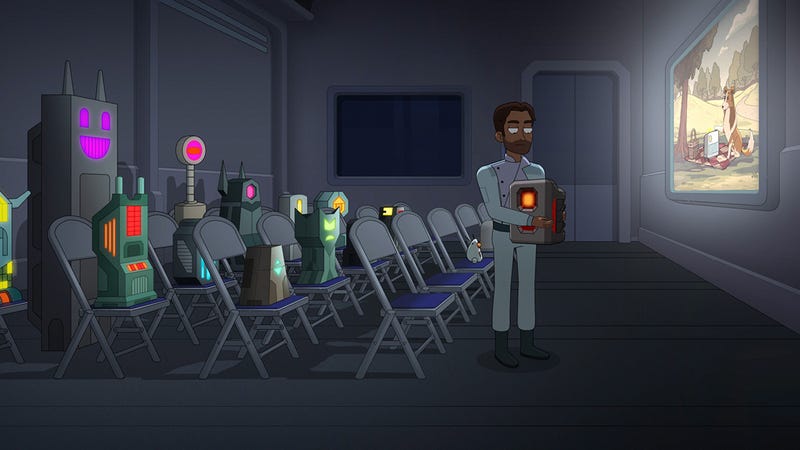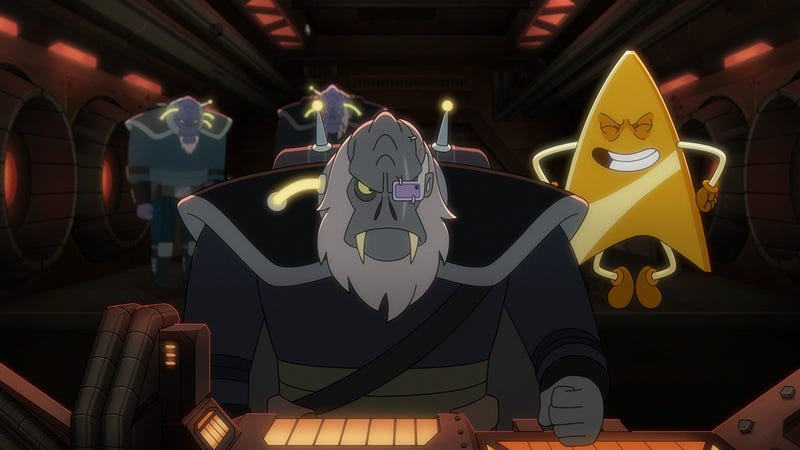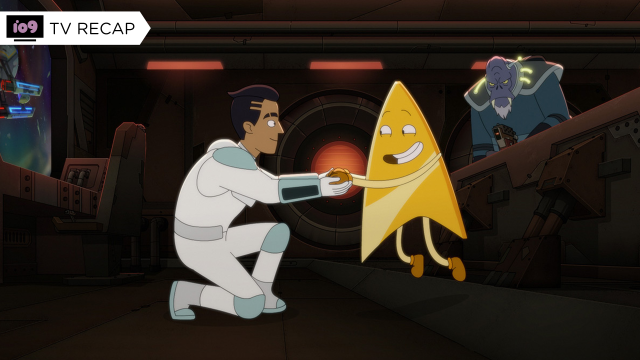Lower Decks does a lot with its love of story threads and nods to past Star Trek, but when it comes to carving out its own true additions to the trope canon those results are often a little mixed—and, weirdly enough, have so far largely focused on one very specific trope, in the form of Trek’s litany of asshole AI villains. This week’s episode acknowledges that in a manner that’s perhaps fittingly mixed.

“A Few Badgeys More” decides to offer up a mishmash of three of Lower Decks’ most original villains, and all three of them some variation of evil computer—a classic Trek trope but here entirely rooted in the contemporary canon Lower Decks has written for itself across four seasons at this point. This is smart, and a fitting example of how far the show has come that it can indeed dedicate its referential love for the stories that it has made for itself in the last few years, instead of wholly relying on foreknowledge from prior Star Trek shows. It’s perhaps less smart when you realise that it means an entire episode dedicated to three characters from the show’s past that have decidedly mixed histories. On the plus side, there’s the return of Jeffrey Combs’ delightfully devilish evil computer Agimus, and it’s really hard for Star Trek to whiff a chance to reuse Jeffrey Combs. On the downside, Agimus is joined by the return of Peanut Hamper—whose “Mathematically Perfect Redemption” went very awry textually and metatextually last season in a oddly mean-spirited episode—and Lower Decks’ somehow longest-running returning threat, the deranged, delta-shaped evil hologram Badgey.

Thankfully, for as randomly mish-mashy as this initially seems beyond the fact that all three returning characters are villainous computer programs, “A Few Badgeys More” does some smart compartmentalizing to avoid feeling too overstuffed, for the most part. Splitting its main group into Mariner and Rutherford dealing with Badgey’s return, having fully plotted his revenge after the events of being abandoned in the season one finale, and Boimler and Tendi being tasked with dealing with a union between Agimus and Peanut Hamper, bonding over imprisonment at the Daystrom Institute—and with the former offering information regarding the season’s overarching thread about the mysterious ship-destroying entity—we really get to see just how far our heroes have come since the previous times they’ve dealt with these threats.
Rutherford’s testy reunion with his “son” pushes him to a lot of limits, and asks him to potentially re-examine some of his own self-sacrificial nature, while Boimler and Tendi working together to investigate just what Agimus and Peanut are really planning (and being aware that the duo are up to something from the get-go) is a fun play on a trope that could’ve otherwise made our promoted heroes feel dumb for the sake of an obvious plot twist. The problem is that even with this smart compartmentalization, there is still a lot going on in this episode… and some of it is much, more more interestingly resolved than others.

Let’s start with what works: the Agimus and Peanut Hamper side of things. Initially a sort of ill-advised computational Bonnie and Clyde, the duo feel smartly fleshed out here as they try (and hilariously fail) to dupe Starfleet into thinking they’ve been redeemed enough to be exonerated of their past exploits—only for poor Agimus to learn that Peanut Hamper has already duped him even further, leading to Bomiler and Tendi being dragged along on his own existential mini-crisis. Meanwhile, Peanut Hamper’s initial tricksiness giving way to an actual redemption unlike her appearance last season—because not only have the people dealing with her, Agimus aside, gotten better at dealing with her previous whiles, but because she has actually learned something and grown and changed in her time at Daystrom—feels like a satisfying make do on the bait and switch of her season three appearance. In the end, the duo might end up separated, with Agimus back at Daystrom and Peanut Hamper having found solace among her fellow Exocomps, but they feel like they have evolved in healthy, interesting ways that satisfyingly bring their arcs to a close, especially if this is the last time we see them. Meanwhile, our heroes are rewarded in aiding these journeys with the actually crucial information that the series’ overarching thread is a mysterious ship capturing vessels, and not actually completely eradicating them.
Badgey, meanwhile… is Badgey. Don’t get me wrong, Star Trek has done a lot with holoprograms-gone-wrong to plenty of fun effect in its long past, but Badgey has long felt kind of one-note even as Lower Decks pushed him hard as this huge, threatening villain. And unlike Agimus and Peanut Hamper’s arcs in this episode, that still kind of feels like the same for Badgey by the end of it. As a villain, he remains one-note, all-powerful, unstoppable, and always capable of just Doing Whatever The Plot Needs to keep amplifying his threat, until he eventually is far-reaching enough to have uploaded himself into every starship and planetary system around to enact vengeance on Rutherford, no matter how many attempts are made to stop him. In the process, Badgey is split into three personas—his evil self, his good self, and his logical self—that feel like they try to add layers to his villainy. But it doesn’t really work when all we’ve seen of Badgey from the get-go is a homicidal, vengeance-seeking baddy, and when, as another aspect of this constant need to make Badgey seem increasingly almighty, he kills his logical self on a whim, rendering the split all the more pointless.

It’s made worse that the only way to climax Badgey’s exponential power growth by the end of the episode is for him to, on the cusp of achieving almighty power and reach across the galaxy, suddenly decide he’s just going to vanish off into the ether and become a Q-esque ascended higher being. The episode has spent this plot thread building and building and building Badgey as this overwhelmingly unstoppable threat that him just simply, well, stopping feels like the show got painted into a corner and just needed to be cut off by any means necessary—and it’s especially unsatisfying as it never really feels like Rutherford had an impact on the conclusion of this personally connected threat. It’s very in Sam’s nature to just be all “Okay, bye!” about Badgey’s ascension, but at the same time, it kind of just feels like the show itself is taking that attitude without earning a reason for it, and none of it really lands.
Which is why it’s also kind of even more frustrating that the episode ends with “Goodgey,” Badgey’s terribly-named “good” persona still hanging around with his father, complete with a tiny little tease that he might not be entirely as good as his name implies. Resetting Badgey back to his initial base self before all the craziness without Rutherford or any of the characters involved having really learned anything feels like it undermines the rest of what “A Few Badgeys More” was going with its other villains. But in a seasons of twisting expectations, maybe the twist here will be that Badgey can now evolve into something more than a one-note villain later down the line. Whether it will have been worth all this, however, remains to be seen.
Want more entertainment news? Check out when to expect the latest Marvel, Star Wars, and DC releases, what’s coming to cinemas in Australia this year, and everything streaming this month across all platforms. Check out our dedicated Entertainment tab for more.
